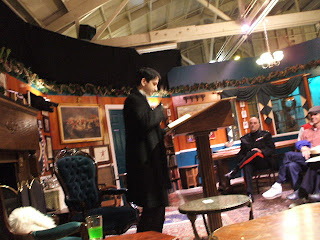December 2,
2012
Being so
busy as we all are during the holiday season, I decided to combine all three of
my costume events together in one entry. Beginning on the first weekend of
December, I flew up to San Francisco to attend the Great Dickens Fair, held at
the Cow Palace in San Bruno.
The weather
was threatening to come down with biblical amounts of rain and wind, but it
stalled a bit so on my arrival it was just light to medium sprinkles. My
roommates, Karen and Joy, and I arrived at the Cow Palace the next morning as
it was beginning to come down heavier. Fortunately by the time we walked from
our car to the building our skirts weren’t too wet. But the next day, when I
was flying home, the torrential rain and winds arrived, causing a lot of damage
around the city and managed to delay my flight eight times. But I made it home
with no mishaps.
I decided I
didn’t need to make anything new for this event since I had two 1860s gowns I’d
never worn there before. I picked my olive green w/ purple trim gown to wear
since it was more of a Winter color, and I wore the straw bonnet I’d trimmed
for it. I brought my maroon paisley shawl which has kept me warm in the past
but this storm was not a cold one and once inside the Cow Palace with the thousand
people, it warmed up very quickly. In fact it was very warm and we were all
fanning ourselves. So much for experiencing London at Christmas time.
If you’ve
never been to this event most people describe it, and I agree, as mindboggling.
It’s entirely indoors using a huge coliseum-size building with many adjoining buildings. In fact, rodeos are
held there, and we saw the cattle gates out in the parking lot. I imagine this
is why it’s called the Cow Palace but I haven’t confirmed that. They recreate
the streets of old London in Dickens time with shops, pubs, and eateries. It
moves from fancy homes, like Tavistock House, down to the run-down wharves.
There are stages on the “wharf” where sailors and bawdy ladies sing old English
songs. At Fezziwig’s people can dance on a huge dance floor. Characters from
all of Dickens novels mingle with the crowds and interact with them. I had a
long conversation with Mr. Tulkinghorn from Bleak House. I sat and listened to
Edgar Allen Poe reading a poem while he sipped absinthe. Ebenezer Scrooge was seen
startling shop owners as he walked along the streets yelling Happy Christmas!
Mr. Dickens himself read parts of his books to visitors of the Green Man Inn, which
by the way is next door to King Edward’s Pub where I purchased eggnog brandies
for my friends and I.
The day I
attended was also the same day the GBACG (Greater Bay Area Costume Guild) was
attending so the number of people attending in period costume was higher. I was
able to spend time with my friends from there and joined in their group photo
shoot.
At the close of the day everyone joins in singing the Messiah at Fezziwig’s where they hold up placards with the words for us to follow along. It’s a great way to end a fun day.
PARADE OF
LIGHTS, EL CAJON, CA -December 12
With a week and a half notice our guild members
were asked if we could provide any costumed walkers for a Xmas-decorated
antique car parade in downtown El Cajon. It was going to be their first one. Alrighty
then, this would be my third parade in two months, and it gave me a chance to
wear my red and black checked 1872 gown. To change it up I decided to
wear my antique hat with it instead of the black & maroon feathered one I
wore last year, and added my antique sealskin muff. The weather was threatening some rain so we were a little nervous but it held off until late in the evening when everything was pretty much over. A large contingent of Steampunk folks showed up and caused a few startled looks from the attendees, but five of us came in historical gowns and also got some attention. Originally we were offered a seat in one of the cars but most had small windows and we really wanted to show off our gowns. So quite a few of us ended up walking behind the different cars. My friends, Cat and Paige, joined me in walking the two block distance.
We don’t
have any photos of us walking in the parade but we took some of each other with
some of the decorated cars. Since Cat has her own vintage car, next year we’re
going to decorate and ride in it ourselves.
During the annual
Holiday in the Park celebration in Old Town San Diego our costume guild held
our December meeting as a holiday dinner at the Cosmopolitan Hotel there. I
think there were about 28 members in a variety of costumes. Some arrived early
and we walked around the town square having our photos taken by people in the
park. We were often asked if we were carolers. We also had Father Christmas
with us and he was the center of many many photos.
Photo by
Jerry Abuan
So now I
have one and a half months to finish my gown for my next event.











































































